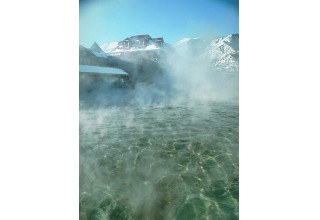Hot Springs Traditions Around the World
Soaking in hot springs is a favorite pastime, not just at Glenwood Hot Springs Resort, but for people from all around the globe. Bathing traditions vary from country to country; find out more about hot springs rituals and learn more about our own.

Soaking in geothermal water has a long history both here at Glenwood Hot Springs Resort and around the globe. Humans have long understood that immersing the body in naturally hot water is splendidly relaxing and may have healing benefits as well. But just like other aspects of culture vary from place to place—food, costume and language—so do the customs surrounding hot springs.
Hot springs are located on all seven continents. Destinations renowned for their geothermal waters include Japan, Taiwan, Turkey, Europe and the U.S.
Onsen. Because Japan sits atop what’s known as the Ring of Fire—a geographical area known for its earthquakes and volcanic activities—it has a prolific number of hot springs. The springs were originally used by Buddhist monks for purification rituals. As the healing properties were discovered, people brought their ill relatives to soak. Over time public bathing became commonplace and a practical way to stay clean. These days, indoor plumbing has solved hygienic problems, but Japanese continue to be big fans of public bathing. Like many places around the globe soaking in Japan’s onsen is done in the buff. Prior to entering the water, visitors are expected to thoroughly wash themselves with soap and water. Men and women are often separated by gender and those with tattoos are typically turned away.
Wen Quan. These are Taiwanese hot springs clustered around the city of Beitou, where Yang Ming Shan—an active volcano—is the source of the thermal waters. Unlike Japan, however, swimsuits are required to soak in the public pools. You might spot people placing small towels on top of their heads; theoretically, doing so will prevent you from fainting by lowering the temperature differential between your body and the geothermal water.
Kurort. European spa culture stems from Roman traditions. The Roman Empire once dominated the land mass of Europe. In fact, the word spa is a Latin acronym—Sanus Per Aquam that translates to health through water. In Germany, doctors often prescribe soaking at hot springs resorts—called kurorts—to patients to reduce stress or treat chronic conditions such as rheumatism. “Kurs” usually last for three consecutive weeks and the cost is covered by health insurance.
Hammam. Also known as a Turkish bath, Hammam has Middle Eastern origins and is associated with the culture of the Ottoman Empire. Hammam rituals typically begin with relaxing in a heated room to induce perspiration. Bathers often move progressively to a hotter rooms, then wash in cold water. The practice culminates with a massage. In traditional hammams, bathers are nude and genders are separated for modesty.
Thermal springs. Native Americans were the first people to regularly use geothermal waters for relaxation, healing and purification. There are approximately 200 commercial hot springs in the United States. Most require pool-goers to wear swimsuits. However, aside from the requirement for pool attire, hot springs in the U.S. are likely among the world’s least formal. While hot springs have a much younger pedigree here than elsewhere, there is a growing interest in balneology—soaking in hot springs for wellness benefits—among Americans.
Glenwood Hot Springs Resort. The world’s largest hot springs pool is located at Glenwood Hot Springs Resort. The main “big” pool contains over one million gallons of water at a temperature of 90-93°F/32-33°C. The smaller therapy pool is maintained at 104°F/40°C. The geothermal water, which flows from the nearby Yampa Spring, contains 15 health-benefiting minerals. As a family-friendly resort you can expect to see children playing, people swimming laps and diving in the deep end in the big pool. Conversely, the smaller and hotter pool is a splash-free zone for relaxing and socializing. The bathhouse features separate locker rooms for men and women, as well as private family changing rooms. Visitors are encouraged to stay hydrated and may bring water bottles with them into the pools. The resort’s Spa of the Rockies offers guests the opportunity for massage, body treatments, facials and nail services. Other resort amenities include 107-room lodge, an athletic club, a poolside restaurant and a boutique store.
Find out more about soaking and staying at Glenwood Hot Springs by visiting www.hotspringspool.com.
Categories: Tourism, Travel, Vacations and Travel
Tags: Glenwood Hot Springs, Glenwood Springs, hot springs, hot springs Japan, hot springs pool, soaking, world wide hot springs
Additional Images
Additional Links
Resort Trends, Inc. - tourism communications




